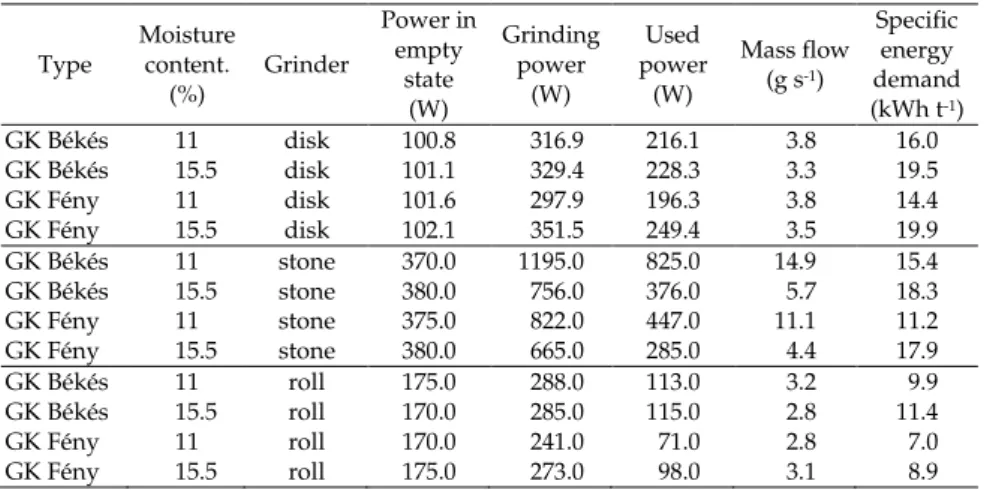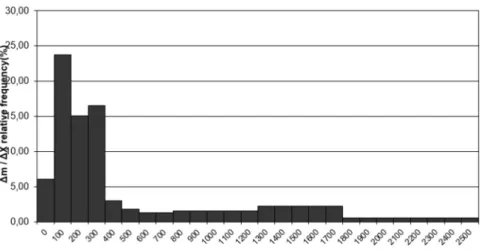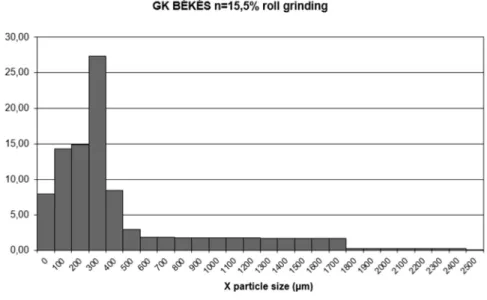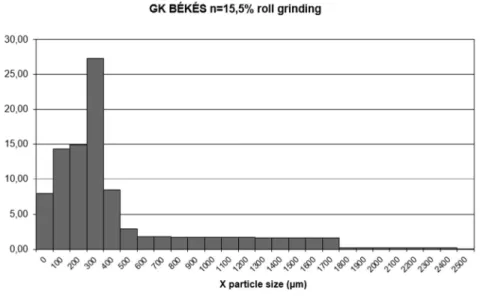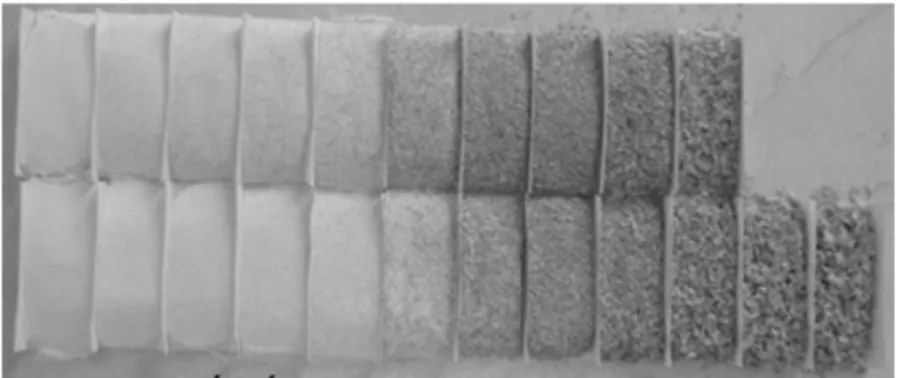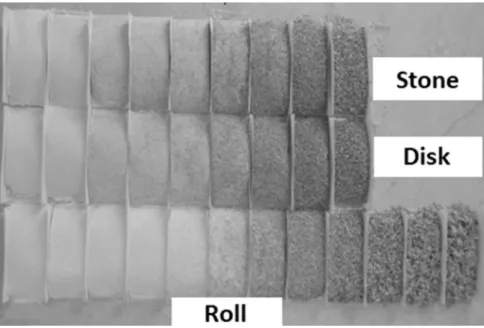Acta Agraria Debreceniensis 150
This volume was published with the support of KITE Plc.
ACTA AGRARIA DEBRECENIENSIS Journal of Agricultural Sciences
This peer reviewed journal of Faculty of Agricultural and Food Sciences and Enviromental Management of the Debrecen University, Debrecen, Hungary.
The Journal of Agricultural Sciences publishes papers in English.
Professional support is provided by Hungarian Academy of Sciences, Section of Agricultural Sciences, Kerpely Kálmán Doctoral School and Animal Husbandry Doctoral School of Debrecen University.
The Journal is published in yearly volumes of two issues annually.
Chair Editor:
Péter PEPÓ (HU) University of Debrecen
Editors in Chief: Editors:
János NAGY (HU) István KOMLÓSI (HU)
Imre HOLB (HU) University of Debrecen
József CSAJBÓK (HU) Levente CZEGLÉDI (HU)
Endre HARSÁNYI (HU) Adrienn KAKUSZI-SZÉLES (HU) Gabriella NOVOTNINÉ DANKÓ (HU)
University of Debrecen
Book Review Editor:
Gyula VASVÁRI (HU) University of Debrecen
Editorial Advisory Board: International Scientific Advisory Board:
László BABINSZKY (HU) Lajos BLASKÓ (HU) Sándor HODOSSY (HU) Csaba GYURICZA (HU)
Béla KOVÁCS (HU) György KÖVICS (HU) Botond SINÓROS-SZABÓ (HU)
Rezső SMITH (HU) Gábor SZÁSZ (HU) János TAMÁS (HU)
Robert G. ELKIN (USA) Andrew U. FRANK (D) Péter GREGORY (UK)
Péter HORN (HU) Miklós NEMÉNYI (HU) Rod J. SUMMERFIELD (UK)
Odd VANGEN (NO) György VÁRALLYAY (HU)
Viktor VERGUNOV (UA) Jeremy WOODS (UK)
Contents
Foreword ………... 9
Péter HORN: Some strategic aspects of animal protein production ………. 11 Miklós MÉZES: Alternative protein sources in the nutrition of farm animals ………... 21 János NAGY – Adrienn SZÉLES: The scientific background of competitive maize production ………. 33 Miklós NEMÉNYI: Precision crop production and artificial intelligence – the future of sustainable agriculture ………. 47
Csaba Dezső ANDRÁS – Bernadette SALAMON – Éva GYÖRGY – Emőke (DOBRI) MIHOK – Alexandru SZÉP: Essential oil extraction from herbs and their use in the food industry ………. 59 Zoltan BERZSENYI: Challenges and agroecological approaches in crop production ………. 75 Márta BIRKÁS: New challenges in soil management ………. 91 Borbála BIRÓ– Anita DUDÁS – Heléna WASS-MATICS – Tamás KOCSIS – Sándor PABAR – Eszter TÓTH – Magdolna Zita SZALAI – Zsolt KOTROCZÓ: Improved soil and tomato quality by some biofertilizer products ……….
93
Lajos BLASKÓ: Amelioration and arable land-use possibilities of Solonetz soils in the Trans-Tisza region of Hungary ……….. 107 Norbert BOZSIK – Róbert MAGDA: Labour productivity in the Hungarian agriculture ………. 119 Nikolett CZIPA – Andrea KÁNTOR – Loránd ALEXA – Béla KOVÁCS: The effect of collecting area on the element content of Hungarian acacia
honeys ……… 129
János CSAPÓ – Csilla ALBERT: Wine adulteration and its detection based on the rate and the concentration of free amino acids ……… 139 Nicolae CSÉP: Sunflower in Romanian agriculture ………. 153
István GONDA – Sándor PAJNA – Ágnes BAY-SZÉPLAKI – Mihály SZILÁGYI: Optimising intensive apple crown pruning by IT improvements ………... 165 Edit HAJDU: Viticulture of Hungary ……… 175 Peter HILSENDEGEN: Comparison of hypersensitive plum rootstocks ….. 183 Agnieszka JASIŃSKA: Spent mushroom compost (SMC) – retrieved added value product closing loop in agricultural production ……….. 185 Márton JOLÁNKAI – Igor DEKEMATI – Mária Katalin KASSAI: Milestones in the development of agronomic management practices in crop production ………. 203 Evelin Kármen JUHÁSZ – Andrea BALLÁNÉ KOVÁCS: Impact of nitrogen and sulphur fertilization on the growth and micronutrient content of spring wheat (Triticum aestivum L.) ………... 211 András JUNG – René MICHELS – Rainer GRASER: Portable snapshot spectral imaging for agriculture ……… 221 Miroslava KAČÁNIOVÁ– Margarita TERENTJEVA– Simona KUNOVÁ– Ľudmila NAGYOVÁ– Elena HORSKÁ– Peter HAŠČÍK– Maciej KLUZ– Czeslaw PUCHALSKI: Identification of the Slovak traditional cheese
“Parenica” microflora ……….. 227 Tünde KAPRINYÁK - Réka LÁPOSI - László BEKŐ - Szilárd TÓTH: Effects of combined nutrient supply treatments on some physiological parameters of autumn wheat ………. 241 János KÁTAI – Magdolna TÁLLAI – Imre VÁGÓ – Andrea BALLÁNÉ KOVÁCS: Changes of some soil chemical and microbiological characteristics in a long-term fertilization experiment in Hungary ………. 253 Tamás KISMÁNYOKY: Long-term field experiments in the crop production and agroecology ……….. 267 Vlado KOVAČEVIĆ: Nutritional disorders of arable crop growth in eastern Croatia ……….. 273 Susanta LAHIRI: Alternatives of synthetic chemicals – chemicals derived from foods and related materials ……….. 291 Dragana LATKOVIĆ – Jovan CRNOBARAC – Goran JAĆIMOVIĆ – Jelena VISKOVIĆ: Production of corn in Serbia in the light of climate change …. 305
Péter Tamás NAGY: Challenges – the impact of climate change on the nutritional management of Hungarian orchards ……… 323 Andrea NEMES – Judit R. HOMOKI – Rita KISS – László STÜNDL – Judit REMENYIK: Effect of anthocyanin-rich Hungarian tart cherry extract on blood antioxidant status in C57BL/6J mice ………. 335 Tomáš ORFÁNUS – Viliam NAGY: Water infiltration into the soil – what do measurements indicate? ……… 343 László ORLÓCI: The state of the Hungarian ornamental horticulture industry, recommendations for development ………. 353 Péter PEPÓ: Long-term experiments on chernozem soil in the University of Debrecen ………... 357 Katalin SÁRDI: Influences of water deficiency on the productivity of young plants at different sites ……… 371 Mihály SÁRVÁRI: Technological development of sustainable maize production and its effect on yield stability ……….. 379 Cyril SIMAN– Yvetta VELÍSKOVÁ: Consumption of fertilizers in districts of Slovakia in the period between 2006 and 2015 ………... 389 Botond SINÓROS-SZABÓ – Máté ZAVARKÓ – Felix POPP – Pau GRIMA – Zoltán CSEDŐ: Biomethane production monitoring and data analysis based on the practical operation experiences of an innovative power-to- gas benchscale prototype ……… 399 István SISÁK – András BENŐ – Mihály KOCSIS: What does precision crop production hold for the future of soil science and plant nutrition? ………. 411 Balázs P. SZABÓ – Zoltán MAGYAR – Antal VÉHA: Examination of different grain hardness varieties of wheats’ grinding technology properties ……….. 423 Emese SZABÓ – Jakab LOCH: Study of factors controlling the amount of 0.01 M CaCl2 extractable Norg fraction ………... 437 Ferenc SZABÓ – Márton SZŰCS– Károly TEMPFLI– Berry DONAGH:
Upgrading breeding value estimation in beef cattle ……….. 451 Mária TAKÁCSNÉ HÁJOS – Tímea RUBÓCZKI: Evaluation of mineral element content of beetroot during the different stages of the growing
season ………. 459
Tibor TÓTH – László PÁSZTOR – Mátyás ÁRVAI – György SIPOS – Katalin TAKÁCS – Márk RÉKÁSI – Gábor SZATMÁRI – Kitti BALOG – Zsófia Adrienn KOVÁCS: Review of research on salt-affected soils in the Debrecen agricultural high educational institutions, with special focus on the mapping of Hortobágy ………. 471 Mária TÖRŐCSIK – Eszter PÁL – Eszter JAKOPÁNECZ: New and innovative consumer demands and expectations on the Hungarian food
market ……… 485
Snežana TRIVUNOVIĆ – Ljuba ŠTRBAC – Dobrila JANKOVIĆ – Draško IVANOVIĆ – Ivan RADOVIĆ – Mile MIRKOV – Ivan PIHLER – Siniša BJEDOV – Momčilo ŠARAN: Livestock production development in AP Vojvodina ……….. 501 József ZSEMBELI – Györgyi KOVÁCS – Krisztina CZELLÉR – Géza TUBA:
Long-term effect of soil management on the carbon-dioxide emission of the soil ……… 515 László ZSOMBIK – Veronika TÓTOK: Impact of the integration of lupine (Lupinus albus) into crop rotation on the extent of soil compaction in the Westsik long-term field trial ………... 529
Examination of different grain … P. B. Szabó et al.
Examination of different grain hardness varieties of the grinding technology properties of wheat
BALÁZS P. SZABÓ – ZOLTÁN MAGYAR – ANTAL VÉHA University of Szeged, Faculty of Engineering, Szeged, Hungary
szpb@mk.u-szeged.hu
Summary
In the mill industry, the purpose of the grinding technology is to separate wheat endospermium and shell and to recover grists. The most important and the highest energy requirement operation is shredding. Flour quantity and quality produced from wheat depends on the variety of wheat that will be shredded, the type of grinding equipment and the condition used before the grinding. For this reason, during my experiments, I ground two grain structured varieties of wheat in laboratory conditions using a disk grinder, stone grinder and roll grinder in air-dry and conditioned states. We measured the equipment’s performance and the produced grist’s particle size distribution, followed by the calculation of the energy requirements of the grinders. In the grinding experiments we compared the ash contents of the different particle sized grist’s fractions to map the wheat’s particular properties.
Keywords: Hungarian wheat varieties, disc grinder, roll grinder, stone grinding
Introduction
Nowadays wheat is one of the most common grain plants. It plays an indispensable role in our everyday nutrition worldwide. Its processing extends to the animal feed as well, but its main role is in the mill industry, as the basic raw material.
The grading based of grain hardness is extremely important for milling and for other industries as well that use wheat flour. In grinding technology the degree of grain hardness of the wheat is proportional to the energy used for grinding, since the grinding of harder grain requires far more energy than soft wheat. In addition the grain hardness rate specifies the conditioning parameters, the flour particle size, the density, the starch damage rate and through this the flour water absorption ability and the flour yield rate. The industries processing various flours select raw materials based on grain hardness and protein content. The hard endosperm structure is closely related to the high yield rate of flour, furthermore the proportion of yields is higher of valuable fractions, the water absorption capacity of the flour is higher and the quality of the bread is also better (Mousia, 2004; Bottega, 2009; Ranieri, 2011).
Examination of different grain … P. B. Szabó et al.
424
In the mill industry our objective of grinding is to separate the wheat’s endospermium and shell part, and to recover grists out of it. The most important and the highest energy-consuming operation is grinding. The flour’s quantity and quality produced from wheat depends on: the variety of wheat that will be ground, the type of grinding equipment and the conditioning used before the grinding. This is the reason that during my experiments we ground two grain structured varieties of wheat in laboratory conditions with a disk grinder, a stone grinder and a roll grinder in air-dry and conditioned circumstances. We measured the equipment’s performance from which we calculated the produced grist’s particle size distribution and the energy requirement of each grinder. In the grinding experiments we compared the ash contents of the different particle sized grist’s fractions to map the wheat’s particular properties.
Material and methods
Our experimental materials were GK Békés and GK Fény. The GK Békés wheat type was published in 2007, because of the increasing demands of the high quality wheats. Its adaptability is excellent, practically it can be grown in any areas of the country. Among its nutritional features, the stable high quality and high quality wet protein content is outstanding.
The GK Fény’s adaptability to extreme weather conditions and different types of soils is very nice. Its resistance to general diseases is excellent, as a result it’s suitable for bio-cultivational bread baking. Its quality is general and standard grade. Its bakery industry classification is B1-A2. The GK Fény can be grown safely in any area of the country.
As we wrote we examined the wheat samples in two different moisture conditions: first 11% “air-dry” and secondly on 15.5%
“conditioned”.
During the experiments we used disk, stone and roll grinder equipment. As disk grinder we used a Perten 3303 laboratory equipment.
The grinding takes place between a stationary and a rotating disk. In this equipment the fineness of the milling can be controlled by adjusting the space between the disks. There are 6 different types on its scale. Our measurement was performed at the lowest gap, “0” position. The disk grinder’s most important technical parameters: motor power 180 W, dial speed 2800 1 per min and the dial’s diameter is 75 mm. The stone grinder was a custom-made equipment and was designed primarily for experimental purposes. The grinding is made by grinding stones located on a horizontal axis. One stone is stationary, the second one is rotating.
The stone grinder’s most important technical parameters: motor power 1500 W, dial speed 735 1 per min, dial’s diameter is 250 mm. The roll grinder was a QC 109 type laboratory mill. In the device the wheat is
Examination of different grain … P. B. Szabó et al.
moving along rolls, that rotate different speed. The size between the rolls is factory-set, and cannot be changed, thus ensuring the stability of the parameters during the experiment. The roll grinder’s most important technical parameters: motor power 480 W; rolls speed 980 1 per min;
peripheral speed is 3.6 m per s; the rolls’ diameter 70 mm; the referral of the rolls is 2.4.
The power of the two-phase disk grinder was measured using Voltcraft Energy Logger 3500 type electric power meter. The power of the three-phase stone and roll grinder was measured by Fluke 435 Series II Power Quality and Energy Analyzer. During the measurements the machines were worked empty for the first minute to determine the power of empty run, and then the wheat samples were measured. During the empty and normal runs using the Voltcraft device we read and recorded every 10 seconds the power that was written on the equipment’s screen, while the Fluke device saved automatically the data every 10 seconds, which data could be used and edited on the computer later. During the grinding we measured the mass of the grist at least three times with stopwatch to determine the mass flow.
One of the most common method of classifying the powders and grists on particle size is the sieve analysis. On each sieve only those fractions can pass through, which are the same size or smaller size compared to the sieve’s holes. During this procedure we used upwardly rising sieves, which were stacked on each other. The wheat materials that are tested is poured onto the top sieve, then the sieve column is subjected to a regular shake movement. At the end of the test we weighed the mass of the materials remained on each sieve. Thus the percentage of all materials can be determined. Also the wheat material can be broken down into average particle size fractions. The sieve analysis was carried out using the Fritsch Analisette 3 type vibration sieve. The series of the sieves consisted of 12, and the dimensions were: 63, 100, 200, 250, 300, 400, 500, 600, 800, 1250, 1800 and 2500 µm. To prevent the clogging of the sieves we used four 20 mm diameter sized rubber balls. We weighed the sieves in empty state. Then we set up the sieve column, and added the 100 g grist, closed the cover, and launched the device. We set 1.5 mm amplitude, and 10 minutes. After the procedure we weighed the sieves and measured the residues’ weight and calculated the percentage of fractions. After the sieve analysis we collected every fractions separately.
The moisture content was measured according to MSZ 6369-4 1987 in drying oven at 130 °C and for two hours from ash content. The samples were weighed in porcelain crucibles, and after incineration it was in oven at 550 °C for 6 hours.
Examination of different grain … P. B. Szabó et al.
426
Results and discussion
In the following Table 1 the measurements of the sample grinding can be seen, that were calculated from the main parameters. Since we could not ensure the dosing stability of the mass flow during the measurement, we compared the energy values to the measured mass flows. The specific energy demand of grinding in kWh per t is shown in Figure 1.
Table 1. The characteristics of grindings
Type
Moisture content.
(%)
Grinder
Power in empty
state (W)
Grinding power
(W)
Used power
(W)
Mass flow (g s-1)
Specific energy demand (kWh t-1)
GK Békés 11 disk 100.8 316.9 216.1 3.8 16.0
GK Békés 15.5 disk 101.1 329.4 228.3 3.3 19.5
GK Fény 11 disk 101.6 297.9 196.3 3.8 14.4
GK Fény 15.5 disk 102.1 351.5 249.4 3.5 19.9
GK Békés 11 stone 370.0 1195.0 825.0 14.9 15.4
GK Békés 15.5 stone 380.0 756.0 376.0 5.7 18.3
GK Fény 11 stone 375.0 822.0 447.0 11.1 11.2
GK Fény 15.5 stone 380.0 665.0 285.0 4.4 17.9
GK Békés 11 roll 175.0 288.0 113.0 3.2 9.9
GK Békés 15.5 roll 170.0 285.0 115.0 2.8 11.4
GK Fény 11 roll 170.0 241.0 71.0 2.8 7.0
GK Fény 15.5 roll 175.0 273.0 98.0 3.1 8.9 Figure 1. Specific energy demand of grinding
From the first chart it can be read at air-dry state (11%) from the two wheat types the GK Békés’ specific energy demand of grinding is higher
Examination of different grain … P. B. Szabó et al.
compared to GK Fény, but due to conditioning (15.5%), this difference can only be felt in roll grinding. The roll grinder has the smallest specific energy demand, the disk grinder has the largest, although there is no significant difference between the disk and the stone grinder. The conditioning in each case increased significantly the energy demand, but this amount was the smallest in roll grinding.
The results we got from the analysis’ fraction volumes for describing the particle distribution we made histograms, in such a way that we divided the individual sieve residues by the following sieves’ size differences. The relative frequency values thus we obtained were depicted as a function of the particle size. Three factors’ (wheat type, grinding device, conditioning) effects can be seen on the following three charts (Figure 2–4).
During the sieve analysis we could observe that the hard type GK Békés has definite mode, while the soft type GK Fény has two mode distribution. GK Fény has produced a much larger quantity flour granule in the range of 100 to 200 µm, while GK Békés has produced the most grains fell within range of 300–400 µm. In addition to this, it can be concluded that in the case of GK Fény has a more spacious distribution.
Figure 2.GK Békés and GK Fény wheat types’ grists’ particle size distribution in conditioned state with roll grinder
Examination of different grain … P. B. Szabó et al.
428
As regards the particle size distribution of the grist of the same wheat sample from the three grinders, on the Figure 3 that can be concluded that there is no difference in the mode particle size, but in the case of roll grinder the spacing of the distribution is significantly different, much larger shell particles were produced than the other two grinders. This shows the separating characteristics of the roll grinder, the core fragments into smaller pieces, meanwhile the shell fragments in larger pieces.
The conditioning effect on GK Békés can be seen on Figure 4. It can be observed that the mode of the particle size did not change after conditioning on 15.5% moisture content, but less smaller grain was obtained and the size range of large shell grains increased. This proves that the separating characteristic is increasing after conditioning.
In addition to the particle size distribution we also wanted to know how much proportion of wheat shells and cores were part of the grain size ranges, as the grinding technology main aim is to separate them.
Therefore, we determined the fractions’ ash content (Table 2).
On the Figure 5 it can be seen the wheat types’ grists’ ash contents on 15.5% moisture content examining roll grinder. The soft wheat GK Fény’s fractions have lower ash contents, but we can find grist on larger size ranges as well. This phenomenon refers to the soft type’s flour-like fragmenting, and the larger particles are flattened while they are grinded, and more core parts can attach to them comparing to GK Békés.
Examination of different grain … P. B. Szabó et al.
Figure 3. The disk, stone and roll grinding’s grists’ particle size distribution on 15.5% moisture content examining GK Békés type
Examination of different grain … P. B. Szabó et al.
430
Figure 4. Particle size distribution at 11% and 15.5% moisture content produced by roll grinder on GK Békés
Examination of different grain … P. B. Szabó et al.
Figure 5. Fractions’ ash content examining 15.5% moisture content, and roll grinding
Examination of different grain … P. B. Szabó et al.
432
Table 2. Sieve fractions’ ash content
Type Moisture content (%) Grinding Ash content (%)
GK Békés 15.5 stone
1.64 1.65 1.19 1.06 1.09 1.50 2.63 5.25 6.75
GK Fény 15.5 roll
0.53 0.57 0.44 0.46 0.59 1.17 2.23 3.60 4.36 4.25 4.33 4.30
GK Békés 15.5 roll
0.74 0.72 0.57 0.52 0.55 1.09 2.54 4.41 5.51 5.60 5.16
GK Békés 15.5 disk
1.61 1.66 1.22 1.15 1.18 1.75 2.77 4.93 7.08
GK Békés 11 roll
1.14 0.73 0.69 0.64 0.92 1.88 3.26 4.89 5.55 5.59
Examination of different grain … P. B. Szabó et al.
The ash content of the fractions produced by each grinders is shown in Figure 6. There is no significant difference between the disk and stone grinder’s ash content. The roll grinder’s separating characteristic shows up here as well. The flours that were produced are much lighter and rich in core parts. The parts that contain high ash content shell parts are bigger, but more core parts are attaching to them, therefore they have a lower ash content.
The conditioning effect can be seen in the Figure 7. The wetter wheat fractions have a lower ash content.
Figure 6. Fraction’s ash content examining GK Békés in conditioned state (15.5%) all three grinders
Figure 7. Fraction’s ash content in GK Békés produced by roll grinder
Examination of different grain … P. B. Szabó et al.
434 Conclusions
The ash content differences can be seen clearly in the fractions on Figure 8–10. The GK Fény’s fractions are lighter than the GK Békés’ (Figure 8).
Examining the GK Békés with roll grinder it is clear that after the conditioning the flours were whiter and the range of size was increased, so the separating character as well (Figure 9). The separating characteristic in the roll grinder comes out on the Figure 10 compared to stone and disk grinders. The size of the range increased and the grains are lighter in smaller range.
Figure 8. First line GK Fény n=15.5%, roll grinder; second line GK Békés n=15.5%, roll grinder
Figure 9. First line GK Békés n=11%, roll grinder; second line GK Békés n=15.5%, roll grinder
Examination of different grain … P. B. Szabó et al.
Figure 10. GK Békés n=15.5% stone, disk and roll grinder
References
Bottega, G.–Cecchini, C.–D'Egidio, M. G.–Marti, A.–Pagani, M. A. (2009):
Debranning process to improve Quality and safety of wheat and wheat products – Tecnica Molitoria International – Yearly issue 67–68.
http://www.openfields.it/doc/110919-openfields.pdf
Mousia, Z.–Edherley, S.–Pandiella, S. S.–Webb, C. (2004): Effect of wheat pearling on flour quality. Food Research International. 37: 449–459.
Ranieri, R. (2011): Wheat debranning: industrial applications on durum wheat.
Open Fields srl. Parma. Italy. September 13th 2011. 6th Annual IAOM Eurasia District Florence. Italy.
